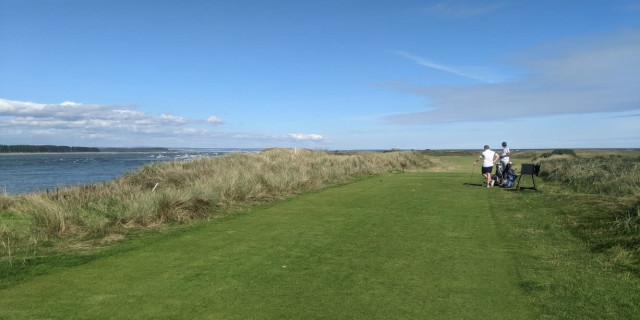
Top 10 Tips For Playing Links Golf
For those unfamiliar with links golf courses, they are generally categorised as courses laid out on sand-based terrain, close to the seafront. Links golf courses throughout the UK & Ireland feature several commonalities, notably related to weather, turf, and style of play. If you’re planning your next links-based adventure, be sure to check out our top 10 tips for playing links golf below!
Come Prepared
Due to the testing, and frequently changing, conditions up and down the coastline of the British Isles, make sure you arrive for your round of links golf well-prepared. It’s certainly advisable to throw a rain jacket into your bag, regardless of how bright it may look on the forecast. You can guarantee that if you don’t, that solitary cloud in the day’s sky will be heading your way. However, if you have been lucky and managed to pick a gorgeous summer’s afternoon, make sure to also pack the suncream, as the wind can often mask the strength of the sun’s rays - your nose and ears will thank you later!
Links courses can be an exacting test of golf, and lengthy rough can swallow golf balls with ease around these courses; ensure you’ve thrown a few extra into the bag. Similarly, it’s advisable to chuck in an additional drink or two. With many links courses being ‘out-and-back’ layouts, you may not be able to nip into the Pro Shop midway around, and if the halfway hut is closed (or nonexistent), you don’t want to get caught out!
Consider Your Clubs
If the pros change up their clubs for links golf, then why shouldn’t you? We see it each year at The Open as the world’s best players trade in their 5 and 7-woods for 2-irons. The firm and fast fairways of links golf in the summer encourages you to get the ball on the ground quickly to make maximum use of the landscape. With current day 2-irons providing much more help than in years gone by, it’s the perfect opportunity to try out your own ‘Tiger Stinger’.
At the other end of the bag, consider just how many wedges you might need. It’s advisable to have something with plenty of loft to help get the ball out of the difficult links bunkers. Whilst the great Seve Ballesteros may have been OK with nothing higher than a 56-degree wedge - we’d suggest us mere mortals make use of all the modern day tools at our disposal!

Steer Clear Of The Bunkers
Speaking of the bunkers…stay out of them, particularly off the tee! In almost all cases, a fairway bunker can be seen as a one-shot penalty around links courses, with their deep faces making it extremely difficult to advance the ball a long way towards the green. Take note of where they are on your course planner, and consider laying short of them from the tee, even if it might mean a slightly longer second shot. Tiger Woods famously stayed out of all 112 bunkers around The Old Course when lifting the Claret Jug at St Andrews in 2000 by hitting mainly irons off the tee - a massive factor in his 8-shot victory en-route to completing the Tiger Slam!
Attack Along The Ground
Closer to the green, don’t be afraid to go in low. The open-fronted nature of links greens can encourage shots that travel in along the ground. Think about ditching your spinny chip (if you’re lucky enough to have that shot!), in favour of the humble chip and run. Or perhaps emulate Todd Hamilton who famously used a Hybrid club to play bump and runs with into greens to devastating effect on his way to winning the 2004 Open at Royal Troon.
Putt It
On the green? Putt it. Just off? Putt it. 30-yards off? Putt it.
The old adage remains true, a bad putt can get as close as a good chip. Wherever possible on links courses, putt it, tap it in, move on to the next!
Don’t Worry About Your Slice (Or Hook!)
One of the best things about links golf for the amateur is a lack of trees lining tees and fairways. This means that you can play a 40-yard slice (or ‘power fade’) with ease, safe in the knowledge that it’s not going to clatter something just a stone’s throw away as it may do on a parkland course! Wind up the driver, and swing away with confidence on the holes that call for the big stick…although remember our earlier point about staying out of the bunkers!

Take Note Of The Wind
It may sound obvious, but the main defence of a links course is the wind, and it has a huge impact on the way the course plays on any given day. Don’t be surprised to see your drive roll out to over 300-yards on one hole, only for you to struggle to clear a bunker at 170-yards on the next. This might be where that 2-iron comes in to chase the ball underneath the wind!
Most importantly though, make sure to have a good handle on the exact direction of the wind when it’s not blowing simply straight up or down a hole. The difference in a shot playing downwind from the left, versus into wind from the left might be as much as 100-yards in the air. Most scorecards have a map of the course on the reverse - you may find it useful to figure out the wind properly on the first hole and draw the direction across the course map with a marker pen, a tip we stole from some of the best caddies in the world!
Leave Your Ego At Home
Related to the 170-yard drive, links golf will humble you on occasion. There’s absolutely nothing wrong with needing to hit a 5-iron to a 110-yard par 3 if that’s the correct shot for the day’s conditions. By all means boast to your friends about the distance of your downwind drives, but they’ll count for nothing if you end up with just 22 Stableford points because you came up short on every approach after being too proud to take one more club.
Get A Move On
Traditionally, members of links course tend to play the game quickly. These clubs were often travelled to for the day by golfers who lived further afield, and as a result, a culture of playing 36-holes (often in twosomes or playing foursomes) was created. These golfers soon realised that the quicker they played, the more time there would be for lunch, which only sped things up further! We’d encourage you to follow suit. It may enable you to squeeze another round in, or prevent you from a four-and-a-half-hour battering from the wind. And if nothing else, it’ll keep you in the good books of the members!
Enjoy The Creativity
We’ve talked plenty here about the different sort of shots required around links courses. Don’t be afraid to give these a go, even if they’re wholly unfamiliar. Poor execution of the correct shot, will often lead to a better result than average execution of the wrong shot! Plot your way around the course and embrace all the challenges links golf will throw at you. Post-round, we guarantee you’ll end up talking the most about shots like the chip and run you tried from 70-yards, the ‘little driver’ you hit into a par 3, or even your own version of the ‘Tiger Stinger’.
Related Content
Tags: links GOLFERS Golf Golf daily picks









